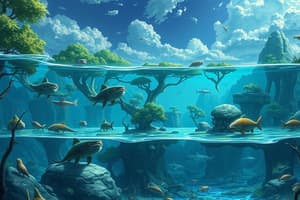Podcast
Questions and Answers
What do primary producers use to create their own energy?
What do primary producers use to create their own energy?
Sunlight through photosynthesis.
What is a food chain?
What is a food chain?
A sequence of organisms where each serves as a source of food for the next.
What is the role of decomposers in food chains?
What is the role of decomposers in food chains?
To break down dead organisms and recycle nutrients for other organisms.
What are trophic levels?
What are trophic levels?
What are omnivorous food chains?
What are omnivorous food chains?
What characterizes stable food chains?
What characterizes stable food chains?
How do organisms interact with several food chains simultaneously?
How do organisms interact with several food chains simultaneously?
What are keystone species?
What are keystone species?
What are trophic cascades?
What are trophic cascades?
Why is understanding food chains crucial for conservation and management?
Why is understanding food chains crucial for conservation and management?
Study Notes
Ecosystems and Food Chains: Unraveling the Interconnected Web of Life
Ecosystems represent the most fundamental units within the natural world, where living organisms and their environments interact in a complex, interdependent way. A central component of these ecosystems is the food chain, which illustrates the flow of energy and nutrients as organisms consume one another in a continuous cycle.
Food Chains: The Backbone of Ecosystems
Food chains are sequences of organisms, where each entity in the chain serves as a source of food for the next. These chains typically begin with primary producers, like plants and algae, which use sunlight to create their own energy through photosynthesis.
The energy created by primary producers then moves up the food chain as animals and other consumers feed on the primary producers, and in turn, they become food for higher-level predators. This energy transfer ultimately affects every organism in the ecosystem, as each species participates in the flow of nutrients and energy.
There are several types of food chains, including:
- Trophic levels: These are categories of organisms based on their roles in the food chain, such as herbivores (plant-eaters) and carnivores (meat-eaters).
- Decomposer food chains: These chains involve the breakdown of dead organisms by decomposers and the subsequent use of nutrients by other organisms.
- Omnivorous food chains: These chains include organisms that eat both plants and animals, creating a more complex interaction among species.
The Complexities of Food Chains
In reality, food chains are far more intricate than they appear, as organisms often interact with several food chains simultaneously. For example, a single plant may provide food for a variety of herbivores, and each herbivore may be a source of food for multiple predators.
Furthermore, food chains can overlap with one another, forming a web of interconnected relationships. This interdependence creates an intricate network of nutrients and energy that flows through the ecosystem.
Stable vs. Unstable Food Chains
Food chains are influenced by various factors, including the population dynamics of the organisms involved. Stable food chains are characterized by a balance between the population sizes of the organisms involved, while unstable food chains are characterized by rapid fluctuations in population size.
Stable food chains are often maintained by various ecological factors, such as predator-prey cycles and the presence of decomposers. Unstable food chains may result in the local extinction of certain species, as an imbalance in population size can cause a cascade of effects throughout the ecosystem.
Keystone Species and Trophic Cascades
Keystone species are organisms that play a disproportionately large role within an ecosystem. By influencing the populations of other organisms, keystone species can have a significant impact on the stability of the food chain and the overall health of the ecosystem.
Trophic cascades are a type of ecological interaction that occurs when the removal or reduction of a keystone species leads to changes in the population dynamics of other organisms. These changes can propagate throughout the ecosystem, affecting both the stability of the food chain and the overall health of the ecosystem.
Ecosystems and Food Chains: Implications for Conservation and Management
Understanding the complexities of food chains is crucial for the conservation and management of ecosystems. By recognizing the critical role that keystone species play in maintaining the stability of food chains, conservationists can take action to protect these species and promote the health of the ecosystem.
Furthermore, an understanding of food chains can help guide the management of ecosystems, as conservationists can identify potential threats to the stability of food chains and take steps to mitigate these threats.
In conclusion, food chains are central to the functioning of ecosystems, serving as a complex and interconnected web of nutrients, energy, and interactions among organisms. By understanding the complexities of food chains, we can better conserve and manage the ecosystems that support life on Earth.
Studying That Suits You
Use AI to generate personalized quizzes and flashcards to suit your learning preferences.
Description
Explore the intricate web of interactions in ecosystems through this quiz. Dive into the complexities of food chains, including trophic levels, decomposer chains, omnivorous chains, and the influence of keystone species. Gain insight into stable and unstable food chains, trophic cascades, and the implications for conservation and ecosystem management.




